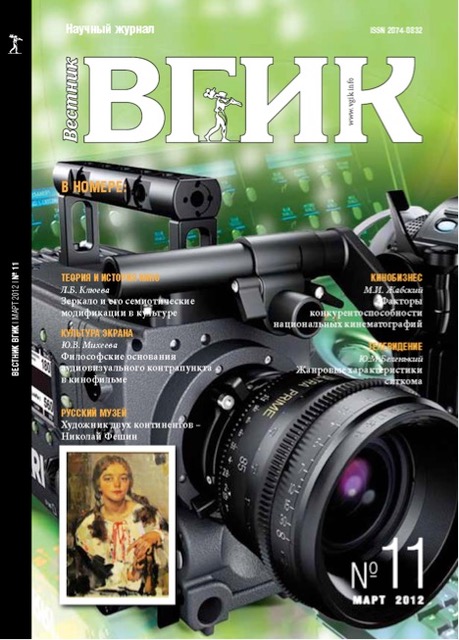Том 4, № 1 (2012)
- Год: 2012
- Статей: 18
- URL: https://journals.eco-vector.com/2074-0832/issue/view/895
- DOI: https://doi.org/10.17816/VGIK41
Статьи
[ библиотека ВГИК ]
Вестник ВГИК. 2012;4(1):133-133
 133-133
133-133


«Кино США на рубеже веков»
Вестник ВГИК. 2012;4(1):134-135
 134-135
134-135


[ библиотека ВГИК ]
Вестник ВГИК. 2012;4(1):150-150
 150-150
150-150


Дом кино. Экспозиция студентов ВГИКа
Вестник ВГИК. 2012;4(1):151-151
 151-151
151-151


Художник двух континентов - Николай Фешин
Вестник ВГИК. 2012;4(1):152-153
 152-153
152-153


ХРОНИКА В ДЕТАЛЯХ | АКТУАЛЬНОЕ СОБЫТИЕ
Вековой юбилей отечественной анимации
Вестник ВГИК. 2012;4(1):4-4
 4-4
4-4


Конкурентная модель платного ТВ
Аннотация
Российская ТВ-индустрия переживает этап бурного реформирования. На фоне внедрения цифровой платформы отечественного наземного эфирного вещания (в рамках ФЦП «Развитие телерадиовещания в Российской Федерации на 2009-2015 годы»), чьи программы в аналоговом виде показываются в свободном доступе, активно формируются иные востребованные сегменты телевизионного рынка - кабельное и спутниковое ТВ, IPTV, интернет-вещание, мобильное ТВ. На примере Международной выставки и форума CSTB'2012 (организаторы - выставочная компания МИДЭКСПО и Ассоциация кабельного телевидения России, АКТР) в статье анализируется динамика процессов в области отечественного телевидения.
Вестник ВГИК. 2012;4(1):136-142
 136-142
136-142


Кабель и спутник: «нехудожественный» контент
Аннотация
В статье рассматриваются результаты проведения третьей по счету Национальной премии «Большая Цифра», посвященной достижениям в области кабельного и спутникового ТВ, что позволяет проанализировать тенденции развития спутникового и кабельного вещания. Несмотря на значительный рост новых цифровых каналов, в силу ограничения их финансирования, можно констатировать отсутствие игрового контента на платных телеканалах. Это накладывает отпечаток на конкуренцию - как в сегменте платного ТВ, так и при его противопоставлении игровым каналам наземного эфирного ТВ, создавая прецедент для перспективного развития «нишевого телевидения».
Вестник ВГИК. 2012;4(1):143-149
 143-149
143-149


ТЕОРИЯ И ИСТОРИЯ КИНО | ЭКРАННЫЕ ИСКУССТВА
Нравственные аспекты русского дореволюционного кинематографа. Яков Протазанов
Аннотация
Данная статья является продолжением темы, поднятой в предыдущем номере журнала (№ 10, 2011). Кинематограф Якова Протазанова - зрелищный, ориентированный на широкую зрительскую аудиторию, отвечающий требованиям рынка и идеологии - был в то же время глубоко связан с нравственной традицией русской культуры. Проблема нравственного выбора, выявление природы зла, борьба между светом и тьмой были лейтмотивом его творчества.
Вестник ВГИК. 2012;4(1):6-15
 6-15
6-15


Зеркало и его семиотические модификации в культуре
Аннотация
В статье исследуются семиотический потенциал понятия «зеркало» и его многочисленные модификации, а также значимость данного понятия для культуры. В работе рассматривается спектр вопросов, связанных с указанной темой, а именно: зеркало как инструмент человеческой культуры; зеркало как средство познания; зеркало как описание чужой структуры (феномен двуемирья); зеркало и психология сновидения; зеркало как модель кинематографа; функции зеркала в структуре фильма.
Вестник ВГИК. 2012;4(1):16-32
 16-32
16-32


КИНОЯЗЫК И ВРЕМЯ | ГЕНЕЗИС ОБРАЗА
О трансформации образа героя в отечественном кино
Аннотация
В статье анализируются особенности построения героического характера в драматургии отечественного кино. На примере картины Ю. Райзмана «Коммунист» (1957) и фильма А. Учителя «Край» (2010) раскрываются особенности создания образа главного героя в советском и постсоветском отечественном кинематографе. Основное внимание автор уделяет взаимодействию героя и социума в сюжетах этих фильмов.
Вестник ВГИК. 2012;4(1):34-43
 34-43
34-43


 44-54
44-54


ПЕРФОРМАНС | ИСКУССТВО ВОПЛОЩЕНИЯ
О четвертом измерении в анимации. Синтетические особенности драматургии кукольного фильма
Аннотация
Исследования четвертого измерения в древнерусской иконописи и в физике ХХ в. позволяют выявить ряд закономерностей, существенных для изучения драматургии. Спектр способов экранного представления нефизической сферы дает возможность исследовать четырехмерное кинопространство. Статья посвящена рассмотрению драматургической модели Ю. Лотмана в хронотопе российского кукольного фильма. Пространственная модель особенно наглядна применительно к анимационному синтезу, свойственному объемной анимации, начиная с самых первых картин. Сегодня сочетание в фильме различных видов изображения является художественным приемом, выходящим далеко за пределы кукольного кино и анимации в целом.
Вестник ВГИК. 2012;4(1):56-69
 56-69
56-69


Об опыте создания виртуального персонажа (анализ сайта «Mouchette.org»)
Аннотация
В статье анализируется произведение медиаискусства «Mouchette.org» с точки зрения формы подачи материала и способа раскрытия образа персонажа. Рассматриваются пространственно-временные особенности организации произведения, система раскрытия основных характеристик персонажа, построенная на интерактивном взаимодействии пользователя с произведением, сочетание художественных и документальных элементов.
Вестник ВГИК. 2012;4(1):70-78
 70-78
70-78


КУЛЬТУРА ЭКРАНА | КУЛЬТУРОЛОГИЯ. ФИЛОСОФИЯ
Философские основания аудиовизуального контрапункта в кинофильме
Аннотация
В статье исследуется контрапункт как смысловое противопоставление звукового и визуального рядов в кинофильме в философско-эстетическом аспекте. Анализируются философские основания, вызывающие к жизни контрапункт как контрастность образов, контрапункт как интеллектуальный парадокс и метаконтрапункт как отношение авторского сознания к тексту в целом.
Вестник ВГИК. 2012;4(1):80-98
 80-98
80-98


КИНОБИЗНЕС | СТРАТЕГИЯ И ТАКТИКА УПРАВЛЕНИЯ
Факторы конкурентоспособности национальных кинематографий (окончание, начало в № 10, 2011)
Аннотация
Почему одна кинодержава доминирует в кинематографическом пространстве Европы, многие - на грани полной утраты кинематографической независимости, а некоторые, будучи сильно зависимыми, все же стремятся постоять за себя и кое-что им удается? В статье (окончание, начало в № 10), подготовленной в Государственном институте искусствознания, на материалах статистики высвечиваются глубинные объективные и субъективные факторы исхода рыночной драмы, заключенной в обозначенном треугольнике соперничества национальных кинематографий.
Вестник ВГИК. 2012;4(1):100-112
 100-112
100-112


ТЕЛЕВИДЕНИЕ | ЦИФРОВАЯ СРЕДА
Жанровые характеристики ситкома
Аннотация
В статье рассматриваются свойства ситкома, которые определяют его как самостоятельный жанр. Значение термина «ситуационная комедия» сравнивается с известными жанрово-тематическими подвидами комедии («комедия положений», «комедия характеров» и пр.), анализируется с исторической точки зрения возникновение характеристик ситкома как телевизионного продукта. Ситкому за все годы существования в эфире удалось сохранить традицию сочетания театральной эстетики и телевизионной природы, что делает его не только самостоятельным жанром, но и в какой-то степени уникальным телевизионным продуктом.
Вестник ВГИК. 2012;4(1):120-132
 120-132
120-132


НАУЧНАЯ ЛАБОРАТОРИЯ | ИССЛЕДОВАНИЯ МОЛОДЫХ
Об этнокультурных стереотипах в кинематографе
Аннотация
В статье рассматриваются принципы и особенности киноязыка, отражающего этнокультурные стереотипы в российских фильмах, снятых в последнее десятилетие. Разнообразие художественно-выразительных средств, используемых в современной российской киноиндустрии, позволяет представить этнокультурный стереотип с разных точек зрения. В качестве примера в статье приводятся кинокартины, где проявляются визуальные стереотипы по отношению к укладу жизни поляков, позволяющие создать устойчивый образ польской национальной идентичности.
Вестник ВГИК. 2012;4(1):114-118
 114-118
114-118













